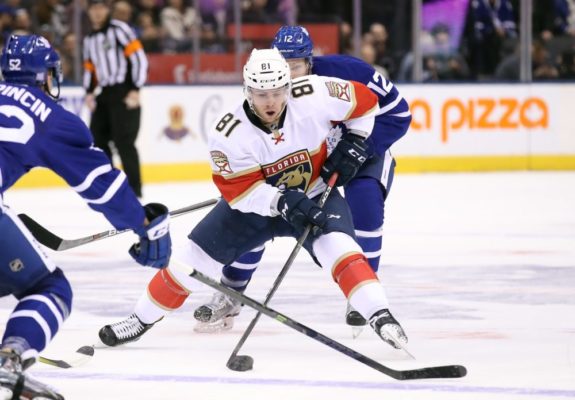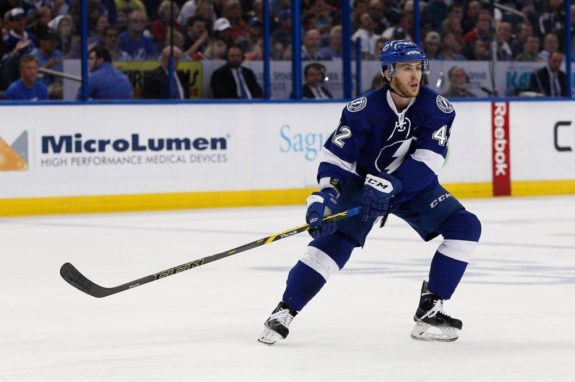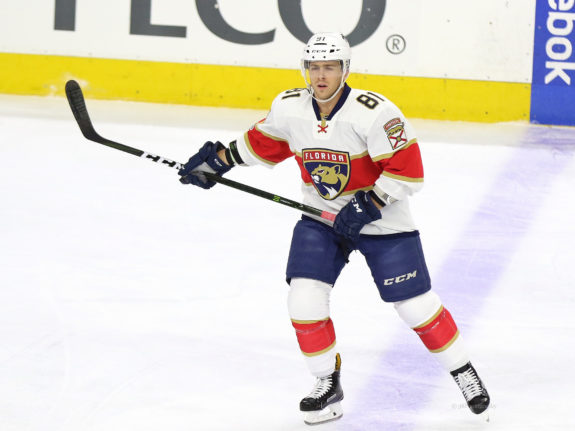Now that the dust of National Hockey League expansion has settled, the Vegas Golden Knights seem set to begin play with a pair of former Florida Panthers in their forward corps. Florida stunned the hockey world with their expansion draft protection list, exposing young scoring forwards Reilly Smith and Jonathan Marchessault.

The question is, what were they thinking? Is there any argument to be made to defend the Panthers?
Smith & Marchessault an Unlikely Package
The Smith situation makes some sense; the winger was coming off a down year (only 15 goals) and has a contract that will pay him $5 million per season for the next five years. This is far too much money for a player whose NHL ceiling seems to be well-established. Everyone wants a 20-goal, 40 or 45-point winger on their team, just not for $5 million. The Vegas Golden Knights are a team that will be desperate for offense, as well as hard-pressed to reach the cap floor – both in 2017-18 and beyond. Production-wise and contract-wise, picking up Smith (who only cost them a fourth-round draft pick) gives Vegas some stability up front.
But leaving Marchessault unprotected is a mystery. The undrafted, journeyman minor-leaguer scored 30 goals (to go along with 21 assists) for a Panthers team cursed by bad puck luck, riddled with injuries and with all the organisational stability of liquid nitroglycerine. A steal at just $750,000 for 2017-18, Marchessault looked like found money: a young, cheap, talented forward who can play both centre and the wing, and whose speed makes him a constant threat in the modern NHL.
Marchessault Lucky or Good?
So just what was behind Marchessault’s spectacular season? Some might say it was a natural progression for a player who’s done nothing but score at every level. Some others might say it was luck. My opinion? Like most things, it’s somewhere in the middle.
Marchessault’s 15.54 percent shooting percentage led the Panthers. And, despite leading the Panthers’ next leading goal-scorer by seven tallies, Marchessault took only the third-most shots on the team (193), well behind the leader (Vincent Trocheck, with 230). So it’s not unreasonable to suggest he got a little lucky.
That said, of the 52 NHL players who potted 25 or more goals (all situations) in 2016-17, Marchessault’s 15.54 percent conversion rate was not egregiously above the group average of 14.19 percent. A group-average shooting percentage would still have left Marchessault with 27 goals. At five-on-five, things looked even rosier. Of the 19 players with 20-plus five-on-five goals, Marchessault’s 8.06 shooting percentage ranked 16th. So maybe he wasn’t so lucky after all.
Exceptionalities in Marchessault’s goal output this past season might not be replicated, but it is also worth noting that the Panthers as a whole were an extremely unlucky team, fifth-last in the NHL in team shooting percentage (6.56 percent, just 0.19 percent clear of the bottom-feeding Colorado Avalanche.). Thus, it is reasonable to assume that his assist totals may see an increase, should his new teammates be able to light the lamp like normal NHL players. Such an increase might just cancel out any regression to normalcy of Marchessault’s goal total.
Marchessault a Defensive Liability?
That all said, Marchessault was second-worst on the Cats at minus-21. Yes, plus-minus is a deeply flawed stat, but it is a stat that sticks out, nonetheless. If you view it as more indicative of team play though, this abysmal mark fuels the argument that the Panthers were pretty darned unlucky last year.
But Marchessault’s PDO was also quite low, mostly due to poor save percentage (sub-.900) when he was on the ice. Again, this can simply be attributed to bad luck. However, the Panthers’ goaltending was reasonably good, not to mention the fact this phenomenon also appears in Marchessault’s numbers from his 45 games the year previous, when he was with the powerhouse Tampa Bay Lightning. So perhaps the Panthers saw something in his defensive game that worried them enough to overrule his offensive talent.

Marchessault’s Numbers Barkov or Bust
Though Marchessault has had fairly good possession numbers throughout his two sample-worthy NHL seasons (including a 51.7 percent Corsi For rating in 2016-17), he has struggled to translate possession into actual performance. Of his most common linemates this past season, it was only when he played with Aleksander Barkov that the Panthers scored more goals (13) than they allowed (12). Only when Barkov was a linemate did Marchessault have a positive Goals For per 60 percentage. And only playing with Barkov was Marchessault able to exceed his average performance on both the offensive and defensive side of the puck.
Marchessault is a versatile player, able to play both centre and the wing. However, his limited time (270 faceoffs) at centre ice this past season saw him win only 45.2 percent of his draws. Thus, is seems as though he is best suited to the wing. Narrower still were the Panthers’ options, as Marchessault seemed to only really excel – at both ends of the ice – when playing with Barkov. The lack of lineup flexibility this reliance bred is another reason the Panthers might have felt it permissible to jettison their leading goal-scorer.
Panthers Sheltering Marchessault?
There is also an argument to be made for the notion that the Panthers’ use of Marchessault sheltered the breakout star. Though not dead-last in either category, Marchessault’s percentage of zone starts in the neutral and defensive zones ranked well below the team average for forwards. Correspondingly, he started in the offensive zone an abnormally high amount of the time.
Additionally, despite leading the team in goals and coming third in points, Marchessault’s average ice time was seventh amongst Panthers forwards, again perhaps indicating sheltered use.
Marchessault Panthers’ Pride or Problem?
It is not unreasonable to suggest Jonathan Marchessault’s exceptional 2016-17 campaign was somewhat of an aberration, fuelled by good usage, good linemates and good luck. Analytically, Marchessault appears to be a gifted offensive player who leaves something to be desired in his own end. If the Computer Boys are still in charge in Florida, it is not unreasonable they would have advocated for Marchessault’s exposure.

But defense can be taught. I’m not so sure you can teach 30 goals. Yes, if he replicates that campaign, you’ll have to pay him like a 30-goal man come summertime. But of all the people you have to pay, why not pay a reliable 30-goal-scorer?
He would also still be a restricted free agent, giving the Panthers some more control over negotiations. And if someone gives him an offer sheet you don’t want to match? Let them have him! You’ll be compensated handsomely.
But what if he doesn’t hit 30 goals this coming season? Or ever again? Great! You still have a versatile offensive forward, only now you can pay him less.
I understand why the Panthers did what they did. I just wholeheartedly disagree.
(All advanced stats are thanks to Puckalytics. All metrics are at five-on-five unless otherwise specified.)